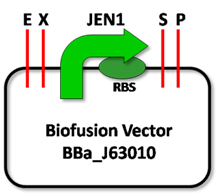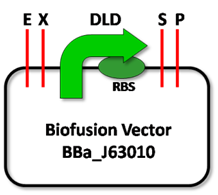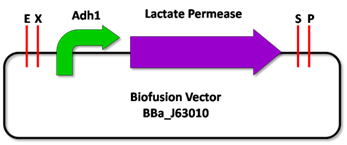The Yeastguard: Recognition
The mechanism of recognition was based on the uptake of lactic acid produced by lactobacilli contaminants of the producing media. The mechanism consists of two devices, while one of them is responsible for the increased sensitivity of the yeasts to lactate the other detects its presence in the interior of the cell and integrates the recognition engine to the killing mechanism.
Increased sensitivity to lactate
The uptake of lactate is made by a permease of monocarboxylate acids encoded by the gene JEN1, which is repressed by glucose (1). Thus, only after the total consumption of glucose available in the media, the yeasts could be able to recognize the contamination. Therefore, to give yeasts the ability to detect contamination in early stages, a device containing the gene JEN1 was designed, being regulated by a constitutive promoter ADH1(BBa_J63005)(Figure 1). The idea is to make the yeasts more sensitive to the presence of lactate, considering that it will be expressing, constitutively, the lactate permease gene. JEN1 is going to be amplified by PCR from the genomic DNA of the yeast Kluyveromyces lactis var. lactis, which is functional in Saccharomyces cerevisiae (3).
Figure 1: Lactate Permease constitutive expression.
Recognition of lactate
The ideal device to realize the presence of lactate in the yeasts´ cytoplasm and activate the killing mechanism must respond to lactate and mustn´t be repressed by glucose. Thus, two promoters were chosen as candidates (2,3): DLD (modified) and JEN1; both found in the genome of the yeast Kluyveromyces lactis var. lactis. These promoters are going to be amplified by PCR from the genome of K. lactis and will include the sites upstream the ATG. The expected amplicons have approximately 1000bp (JEN1) and 471bp (DLD).
 
Figure 2: JEN1 and DLD promoters from Kluyveromyces lactis.
References
Casal M, Paiva S, Andrade RP, Gancedo C and Leao C. 1999. The lactate-proton symport of Saccharomyces cerevisiae is encoded by JEN1. J Bacteriol 181, 2620-2623.
Lodi T, Goffrini P, Bolondi I and Ferrero I. 1998. Transcriptional regulation of the KlDLD gene, encoding the mitochondrial enzyme D-lactate ferricytochrome c oxidoreductase in Kluyveromyces lactis: effect of Klhap2 and fog mutations. Curr Genet 34, 12-20.
Queiros O, Pereira L, Paiva S, Moradas-Ferreira P and Casal M. 2007. Functional analysis of Kluyveromyces lactis carboxylic acids permeases: heterologous expression of KlJEN1 and KlJEN2 genes. Curr Genet 51, 161-169.
|






|
 "
"

















